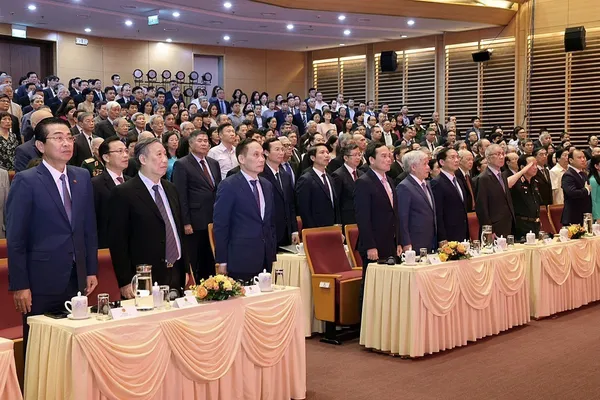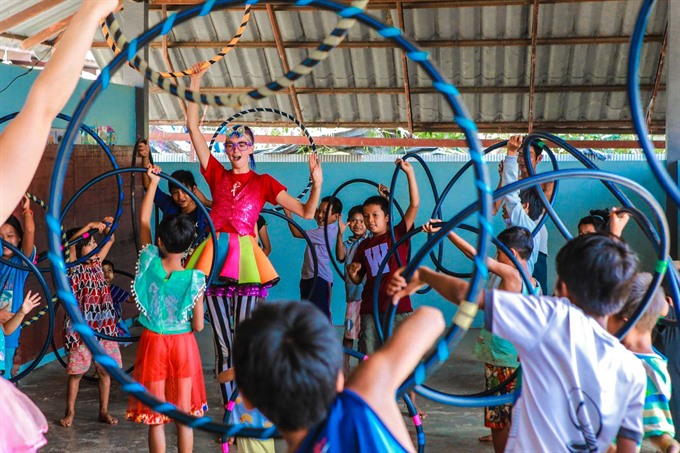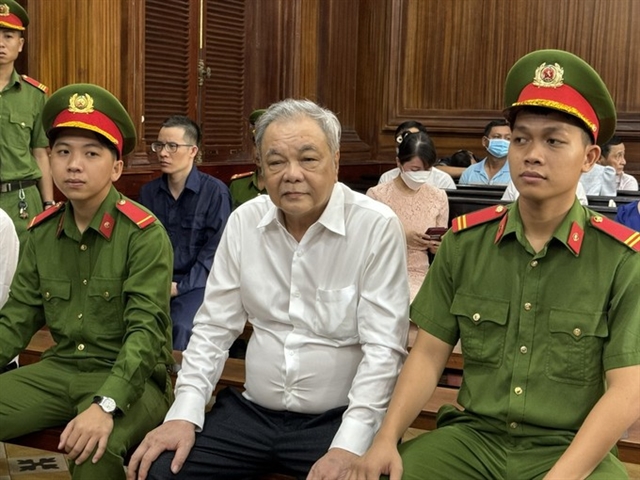

Nguyễn Anh Tuấn could not speak the language of refugee children he met in other countries. However, he managed to teach them hip-hop dancing.
 |
| Spark Circus volunteers give children tools and circus lessons. — VNS Photo Phương Vũ |
Nguyễn Anh Tuấn could not speak the language of refugee children he met in other countries.
However, he managed to teach them hip-hop dancing.
For Nguyễn Anh Tuấn, hip-hop is more than just exercise.
It is a spiritual experience too.
By Bích Hường
Since 2013, Nguyễn Anh Tuấn has travelled every year to neighbouring countries including Thailand, Laos, Myanmar and the Philippines to teach hip-hop to street children and other disadvantaged youngsters.
The 29-year-old first became a volunteer seven years ago after he met Jerry Snell – a Canadian dance choreographer and hip-hop veteran who visited Việt Nam to promote his Street Art for Street Kids initiative, teaming up with the country’s top street dance crews with shelters for vulnerable children to offer dance lessons and companionship.
“In a summer day in 2012, when I was teaching hip-hop to youngsters in Hà Nội’s Lenin Park, a foreigner came and asked me if I wanted to go to Thailand to teach hip-hop to street children,” Tuấn remembered.
“It was Jerry [Snell] and he told me about his ‘Street Art for Street Kids’ and ‘Social Circus’ which use the language of the circus to communicate with people and bring joy to the community,” Tuấn said.
“Jerry’s invitation was sudden and big surprise to me. I agreed,” Tuấn said.
For his first trip to Thailand with Snell [who died two years ago], Tuấn travelled to Pattaya, Bangkok and Chiangmai where he, together with circus performers from many countries offered circus and hip-hop lessons to street children.
The lessons were expected to utilise the collaborative and creative spirit of arts to guide vulnerable children away from violence and crimes.
At that time, the trip to Thailand was considered Tuấn’s second bold decision.
Earlier, when he was a 3rd-year student at FPT University – a private information technology university in Hà Nội, he decided to halt his studying and started practising hip-hop on the streets instead of the university’s club.
“No one in my family has a job related to arts or dancing. My parents did me no favours as they believed that as a school dropout I lost opportunities for the future,” Tuấn said.
“At the age of 21, I was old enough to make a decision on my own and I informed my parents of the decision.
“When I dance hip-hop, I’m myself the most."
Tuấn explained: “The world of hip-hop is not only about dance but also graffiti, beatboxing and music production — the creation of hip-hop music. It’s worth exploring and I can challenge myself much with hip-hop.
"Moreover, as a dancer who practises in a group, the group becomes your second family where every member cares and shares with each other.”
To Tuấn, dancing is not only a physical exercise, or a spiritual remedy but a way of communication.
He said that dancing helped him keep balance in both physical and mental health as well as generate positive energy in him.
Spreading positive energy
“Dance-teaching tours have shown me the way. Literally, the volunteering lights up the way I chose for my life and leads me to other meaningful ways,” Tuấn said.
He said that in the most recent volunteer tour "Spark Circus" he joined in February 2018, he travelled to Mae Sot — a district in western Thailand that shares a border with Myanmar to the west.
Tuấn and other volunteers arrived in one or two refugee camps which are home to thousands of children.
Living conditions at the border area and in camps were quite poor. They were given daily necessities by non-governmental organisations and the Thai government but children there hardly had a chance to practise artistic activities or even have a playground.
Tuấn said that when he and the circus arrived at the camps, children were excited to welcome the guests.
“The children shouted loudly, laughed and concentrated on the hip-hop dances and circus performances,” Tuấn said, adding that their visible happiness encouraged the performers.
“When we – clowns, acrobats, dancers, hoopers or magicians – gave them tools, instrument and instructed them on some simple performances, the children looked very happy,” Tuấn said.
“Without speaking their mother tongue, as a hip-hop dancer, with the movement of legs, arms and the whole body, I could easily teach them some dance lessons,” Tuấn said.
“With some music, few words like ’right’, ’left’, ’go around’ or ’five, six, seven, eight’, I found no barrier between me and the children,” Tuấn said.
“It seems that to such children, the guests’ visits and playing with them was enough to make them happy.”
“A friend of mine, a Canadian volunteer who performs as a clown said to me that when we do this volunteer work to bring the children joy, it’s like God sends angels to Earth to make life better,” Tuấn said, adding that he found the meaningfulness of his voluntary work.
He also had nice memories of volunteering.
During a trip to Mea Sot District, his group performed at a hospital for children. The volunteers talked, taught and played with the children without being aware the children were suffering from diarrhoea. After leaving the hospital, one by one, many persons in the group suffered from diarrhoea too.
In his studio – No 6 Dance Studio at 11 Trần Thái Tông Street in Hà Nội – Tuấn began classes for young hip-hop lovers. He keeps challenging himself with new exercises, inspiring others and preparing his next voluntary trips.
Tuấn said that next year, Social Circus planned to come to Việt Nam. — VNS
GLOSSARY
Since 2013, Nguyễn Anh Tuấn has travelled every year to neighbouring countries including Thailand, Laos, Myanmar and the Philippines to teach hip-hop to street children and other disadvantaged youngsters.
Disadvantaged means having things in your life that work against you.
The 29-year-old first became a volunteer seven years ago after he met Jerry Snell – a Canadian dance choreographer and hip-hop veteran who visited Việt Nam to promote his Street Art for Street Kids initiative, teaming up with the country’s top street dance crews with shelters for vulnerable children to offer dance lessons and companionship.
A volunteer is someone who is willing to offer his, or her, time to do work without being paid for it.
A choreographer is someone who designs dance steps.
Someone who is a veteran knows a lot about a certain topic and has lots of experience with it.
To promote something means to say good things about it and to make sure lots of people get to know about these things you are saying.
“In a summer day in 2012, when I was teaching hip-hop to youngsters in Hà Nội’s Lenin Park, a foreigner came and asked me if I wanted to go to Thailand to teach hip-hop to street children,” Tuấn remembered.
A foreigner is someone from another country.
“It was Jerry [Snell] and he told me about his ‘Street Art for Street Kids’ and ‘Social Circus’ which use the language of the circus to communicate with people and bring joy to the community,” Tuấn said.
To communicate means to send messages from one place to another. It may involve an audience hearing what an actor is saying, someone reading what someone else has written, two people talking to one another, a train driver pressing the horn of a train to warn people not to be on the track, a dog barking to scare off a thief, and so on.
The lessons were expected to utilise the collaborative and creative spirit of arts to guide vulnerable children away from violence and crimes.
Utilise means use.
Collaborative means working together.
Creative means using imagination.
At that time, the trip to Thailand was considered Tuấn’s second bold decision.
Bold means brave.
Earlier, when he was a 3rd-year student at FPT University – a private information technology university in Hà Nội, he decided to halt his studying and started practising hip-hop on the streets instead of the university’s club.
Information technology is the science that deals with computers and the information they are able to make sense of.
Halt means stop.
“My parents did me no favours as they believed that as a school dropout I lost opportunities for the future,” Tuấn said.
Opportunities are chances.
Tuấn explained: “The world of hip-hop is not only about dance but also graffiti, beatboxing and music production — the creation of hip-hop music. It’s worth exploring and I can challenge myself much with hip-hop.
Graffiti is art on public places that is often not allowed to be posted there, which may also have a message.
Beatboxing means making the sounds of a drum with your voice.
He said that dancing helped him keep balance in both physical and mental health as well as generate positive energy in him.
Mental means to do with the mind.
Generate means “make”.
Literally, the volunteering lights up the way I chose for my life and leads me to other meaningful ways,” Tuấn said.
To say something literally means to use words that do not quite apply to what you are saying but give emphasis. In this case, there are no real lights shining anywhere but volunteering gave Tuấn a sense of seeing where he was going, the same way a lit path would make it possible for a walker to see where he is going.
Tuấn and other volunteers arrived in one or two refugee camps which are home to thousands of children.
Refugees are people who have had to leave their homes because it is not safe for one reason or another.
They were given daily necessities by non-governmental organisations and the Thai government but children there hardly had a chance to practise artistic activities or even have a playground.
Necessities are things that you need.
A non-governmental organisation is an organisation that does caring work that often are similar to what governments do.
“The children shouted loudly, laughed and concentrated on the hip-hop dances and circus performances,” Tuấn said, adding that their visible happiness encouraged the performers.
Concentrated means focussed.
If something is visible it can be seen.
“When we – clowns, acrobats, dancers, hoopers or magicians – gave them tools, instrument and instructed them on some simple performances, the children looked very happy,” Tuấn said.
Acrobats are people who perform spectacular gymnastic movements.
“Without speaking their mother tongue, as a hip-hop dancer, with the movement of legs, arms and the whole body, I could easily teach them some dance lessons,” Tuấn said.
Your mother tongue is your home language.
The volunteers talked, taught and played with the children without being aware the children were suffering from diarrhoea.
Diarrhoea is a disease that causes people to have runny stomachs and to need to go to the toilet very often.
He keeps challenging himself with new exercises, inspiring others and preparing his next voluntary trips.
When people are inspired, they get energy to want to go out and do something positive.
WORKSHEET
State whether the following sentences are true, or false:
© Duncan Guy/Learn the News/ Viet Nam News 2018
1. True; 2. False; 3. True; 4. True; 5. False.









